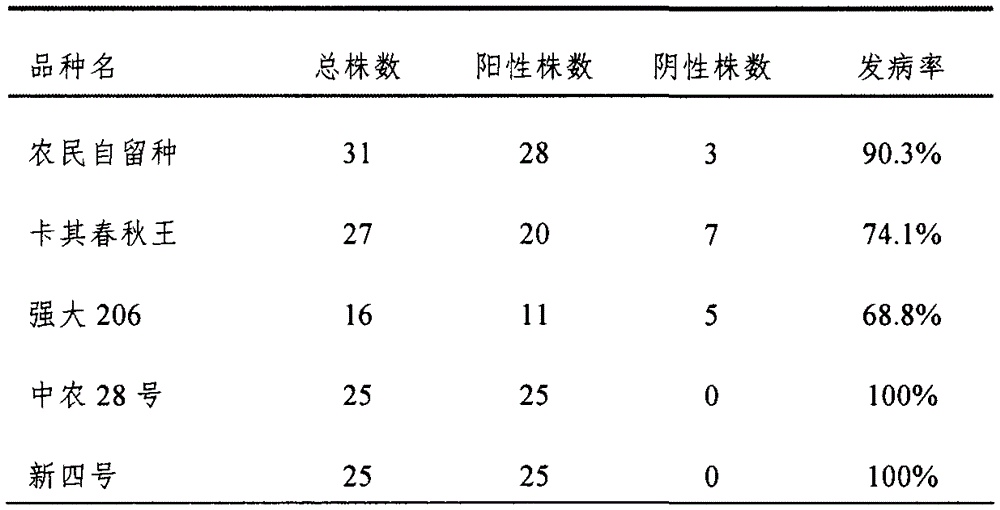Virus stabbing inoculation method for cucurbitaceae crops
A technology of cucurbit crops and virus inoculation, applied in the biological field, can solve the problems of excessive damage to cells and plants, time-consuming and labor-intensive problems, and the inability to fix the amount of diseased sap.
- Summary
- Abstract
- Description
- Claims
- Application Information
AI Technical Summary
Problems solved by technology
Method used
Image
Examples
Embodiment 1
[0015] Comparison of Morbidity Rate of Several Different Vaccination Methods
[0016] 1.1 Test materials and methods
[0017] The gourd seeds were sown in 32-hole hole trays and placed in the greenhouse until they germinated naturally and grew until two true leaves unfolded. Pick 1-2 diseased leaves infected with CGMMV, add a little quartz sand and an appropriate amount of phosphate buffer in a mortar, grind thoroughly, and prepare diseased juice for later use. The constructed invasive clones were activated and grown to OD600 of about 0.6 at 28°C at 200 rpm to collect the bacteria by centrifugation and resuspended with 1 / 2 MS, adding acetosyringone at a final concentration of 100 μmol / L for later use.
[0018] Friction inoculation: Sprinkle a little quartz sand on the leaves of the plant first, dip the diseased juice with your fingers and apply it back and forth gently.
[0019] Infiltration method: lightly puncture the back of the leaf with a syringe needle a few times, the...
Embodiment 2
[0026] Identification of Cucumber's Resistance to CGMMV by Acupuncture Inoculation
[0027] 1.1 Test materials and methods
[0028] Cucumber seeds (Table 1) of 15 different varieties were sown in 32-hole plug trays and placed in the greenhouse. After they germinated naturally and grew until the first true leaf unfolded, they were used for virus inoculation. Pick 1-2 diseased leaves infected with CGMMV, add a little quartz sand and an appropriate amount of phosphate buffer in a mortar, grind them thoroughly, and prepare diseased juice. Dip the diseased juice with an acupuncture needle and puncture the hypocotyl of the plant N times (N refers to 1-10 times), and dip the diseased juice once for each plant inoculated. The inoculated plants were placed in the greenhouse for normal management, and after 20 days of growth, the leaves of each plant were collected to detect the virus infection by ELISA.
[0029] 1.2 Test results
[0030] Through post-inoculation testing, it was foun...
Embodiment 3
[0035] Identification of Rootstock Pumpkin's Resistance to CGMMV by Acupuncture Inoculation
[0036] 1.1 Test materials and methods
[0037] Rootstock pumpkin seeds (Table 2) of 15 different varieties were sown in 32-hole plug trays and placed in a greenhouse. After they germinated naturally and grew until the first true leaf unfolded, they were used for virus inoculation. Pick 1-2 diseased leaves infected with CGMMV, add a little quartz sand and an appropriate amount of phosphate buffer in a mortar, grind them thoroughly, and prepare diseased juice. Dip the diseased juice with a crochet needle and prick N times at the hypocotyl of the plant (N refers to 1-10 times), and dip the diseased juice once for each inoculated plant. The inoculated plants were placed in the greenhouse for normal management, and after 20 days of growth, the leaves of each plant were collected to detect the virus infection by ELISA. Plants inoculated by rubbing at the same seedling age were used as the...
PUM
 Login to View More
Login to View More Abstract
Description
Claims
Application Information
 Login to View More
Login to View More - R&D
- Intellectual Property
- Life Sciences
- Materials
- Tech Scout
- Unparalleled Data Quality
- Higher Quality Content
- 60% Fewer Hallucinations
Browse by: Latest US Patents, China's latest patents, Technical Efficacy Thesaurus, Application Domain, Technology Topic, Popular Technical Reports.
© 2025 PatSnap. All rights reserved.Legal|Privacy policy|Modern Slavery Act Transparency Statement|Sitemap|About US| Contact US: help@patsnap.com



